Abstract
This study investigates the integration of advanced optimization algorithms within energy-intensive infrastructures and industrial plants. In fact, the authors focus on the dynamic interplay between computational intelligence and operational efficiency in wastewater treatment plants (WWTPs). In this context, energy optimization is thought of as a hybrid process that emerges at the intersection of engineered systems, environmental dynamics, and operational constraints. Despite the known energy-intensive nature of WWTPs, where pumps and blowers consume over 60% of total power, current methods lack systematic, real-time adaptability under variable conditions. To address this gap, the study proposes a computational framework that combines hydraulic simulation, manufacturer-based performance mapping, and a Memetic Algorithm (MA) capable of real-time optimization. The methodology synthesizes dynamic flow allocation, auto-tuning mutation, and step-by-step improvement search into a cohesive simulation environment, applied to a representative parallel-pump system. The MA’s dual capacity to explore global configurations and refine local adjustments reflects both static and kinetic aspects of optimization: the former grounded in physical system constraints, the latter shaped by fluctuating operational demands. Experimental results across several stochastic scenarios demonstrate consistent power savings (12.13%) over conventional control strategies. By bridging simulation modeling with optimization under uncertainty, this study contributes to sustainable operations management, offering a replicable, data-driven tool for advancing energy efficiency in infrastructure systems.
1. Introduction
There is a global attention on sustainability and environmental protection, which makes energy efficiency a critical objective across industrial sectors [1]. The advent of Industry 4.0, marked by the integration of advanced technologies such as modeling and simulation (M&S) and artificial intelligence (AI), offers a major opportunity for transforming operations management into more sustainable, efficient, and intelligent systems [2]. This imperative aligns closely with the United Nations’ 17 Sustainable Development Goals (SDGs), particularly Goal 6: “Ensure availability and sustainable management of water and sanitation for all.” Wastewater treatment plants (WWTPs) are energy-intensive public infrastructures [3] that can benefit from the application of AI-driven optimization strategies. In the United States alone, WWTPs account for approximately USD 4 billion in annual energy expenditures, equivalent to around 56 billion kWh [4]. Moreover, their operations result in an estimated 45 million tons of greenhouse gas emissions annually [5]. In fact, the energy required for these plants accounts for 75% of their carbon footprint, with 59% attributed to electricity, 12% to natural gas, and 5% to transportation-related activities [6]. Reducing energy consumption in WWTPs is therefore critical not only for cost savings, but also to achieve global clean energy and climate targets, such as those outlined in the 2015 Paris Agreement within the “2030 Climate & Energy Framework” [1].
Furthermore, wastewater treatment plants (WWTPs) are characterized by several interconnected fluid-handling systems, primarily involving networks of pumps and blowers. It is well known that WWTPs are energy-intensive, with pumps and blowers consuming over 60% of total power [7]. These systems operate under the influence of numerous dynamic variables, including fluid density, pressure, temperature, and humidity, all of which greatly impact energy consumption [8]. It is important to consider that plant operators face the complexity of these variables every working day. Mostly, they have to deal with standardized values that do not apply to the real operating system, increasing the difficulty of process management [8,9]. To effectively support their decision-making within the Industry 4.0 landscape, advanced tools are essential [10]. These tools must adopt a holistic, system-wide perspective, moving beyond the restrictive assumptions often inherent in traditional analytical models. Framing this challenge within the principles of operations management enables a more contextualized and integrated approach to the optimization problem, capturing the complexity of real-world systems and supporting informed decisions [11].
To this end, this research presents a modeling and simulation approach, integrated with advanced optimization algorithms to support operations management in WWTPs. Using the capabilities of AI, these tools can provide real-time guidance directly applicable to real-world operational scenarios, ultimately driving sustainable operations management. This work contributes to the evolving paradigm of energy efficiency by applying a Memetic Algorithm (MA) [12], a specialized evolutionary algorithm, to the challenge of optimizing fluid-handling systems in wastewater treatment plants. These components are not only responsible for a substantial portion of overall energy consumption, but they are also essential for process continuity. By addressing their performance through advanced optimization, it is possible to enable energy savings and promote environmentally responsible operations.
Memetic Algorithms stand out as an effective hybrid metaheuristic for addressing complex optimization problems, by employing a population-based approach for global exploration combined with local search strategies for individual refinement [13]. This nature makes them suitable in optimization landscapes characterized by vast dimensionality, intricate interdependencies between decision variables like pump speeds and blower airflow, and non-linear objective functions related to energy consumption, making traditional analytical optimization techniques insufficient [14]. MAs have been successfully applied in various domains, including the development of energy-efficient scheduling solutions for distributed flexible job shops. Notably, they have been used to address problems involving transportation delays and machine start–stop constraints, with the goal of minimizing both completion time and energy use. This highlights their adaptability and effectiveness in solving real-world industrial optimization challenges [15].
On the other hand, it is widely recognized that simulation is a very powerful tool for supporting decision problems and evaluating the performance of potential solutions within industrial systems like WWTPs [16]. These facilities exhibit high complexity, as mentioned before, due to the intricate relationships linking variables such as fluid density, pressure, temperature, humidity, and flow rates, as well as the fluctuating nature of operational parameters like wastewater inflow and organic load. This complexity often prohibits the effective use of analytical methods and models unless they are extremely simplified [17]. Even if such variables can be incorporated into analytical models, their accurate evaluation and use for predictive purposes (i.e., optimal control of pumps and blowers for energy efficiency) necessitate data collection in a real WWTP environment, appropriate distribution fitting, and the use of simulation to observe the dynamic evolution over time of the equations governing these variables and their impact on system performance [18].
Regardless of whether the incoming water is industrial or domestic [19], treatment plants employ a series of stages as simply demonstrated in Figure 1, pre-treatment, primary treatment, secondary treatment, and tertiary treatment [17], each relying on pumps and blowers and collectively accounting for a substantial portion of the facility’s energy consumption. In the pre-treatment stage, pumps lift the influent, while blowers are used in aerated grit chambers to create a spiral flow that helps separate heavier inorganic materials like sand and grit from wastewater. The energy consumed in this stage is relatively small compared to other processes but is essential for preventing damage to downstream equipment and improving the efficiency of subsequent treatment phases. For scum removal in primary treatment, air blowers are used to aid in the collection of floating materials like fats, oils, and grease by creating froth that can be easily skimmed off the surface, while pumps transfer settled sludge.
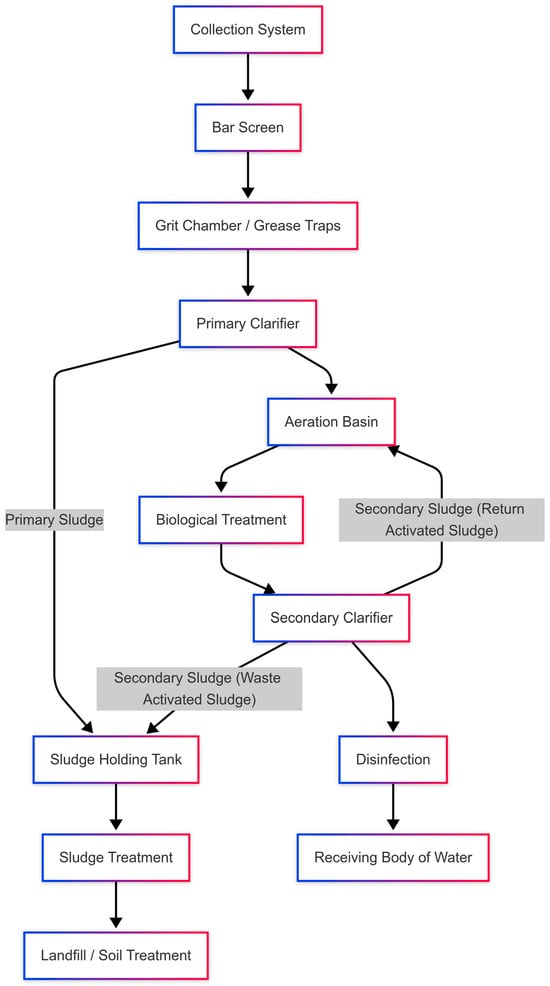
Figure 1.
Simple representation of a WWTP’s phases.
The secondary treatment stage is where the most prominent energy consumption occurs, particularly in biological processes and associating pumping operations. Biosorption aeration blowers and bioreactor aeration blowers are critical for supplying the necessary oxygen to the aerobic microorganisms that break down organic pollutants in the wastewater. The energy demand depends on factors like the size of the plant, the organic load in the wastewater, the type of aeration system used (e.g., fine bubble diffusers are generally more efficient than coarse bubble diffusers), and the depth of the aeration basins.
Advances in optimizing centrifugal machines that are used in WWTP have been driven by the adoption of higher-efficiency motors. These advanced motors, often adhering to standards like IEC 60034-30-1 or NEMA MG 1, incorporate superior materials, optimized designs, and tighter manufacturing tolerances to minimize electrical and mechanical losses. Lately, variable-frequency drives (VFDs) have notably improved system efficiency by regulating motor speed precisely according to actual demand, rather than relying on inefficient control methods such as throttling valves or bypass vents, which dissipate energy as heat or unused flow.
However, the mere presence of high-efficiency components like advanced motors and VFDs does not automatically guarantee optimal performance across all operating conditions [19]. On-field data and feedback from WWTP operators show frequent scenarios where systems, despite having these advanced components, operate inefficiently due to suboptimal control strategies that force the pumping component to function outside its Best Efficiency Point (BEP) [20]. For instance, operators might manually override VFD controls or implement control loops that prioritize a specific process parameter without considering the efficiency of the centrifugal machine at the resulting operating point [21]. Observations often reveal situations where pumps are forced to operate at very low or very high flow rates compared to their design conditions, leading to increased energy consumption and potential equipment wear. Many pumps are selected with excessive safety margins or without accurately accounting for correction to operating conditions [22]. In fact, WWTPs and HVAC systems report up to 30% efficiency losses due to incorrect pumping component sizing [23].
Consequently, there is a critical need for a holistic optimization approach that evaluates pumping systems within their entire operational context, rather than focusing solely on selecting high-efficiency components [24]. This comprehensive perspective demands a detailed understanding of the complete performance map of pumping components (whether blowers or pumps), capturing efficiency variations across the full spectrum of operational conditions including speed, flow rates, and pressures. Additionally, it must consider the dynamic behaviors of the overall system, encompassing pipe friction losses, static head conditions, diffuser performance, valve positioning, and the inherently fluctuating process demands typical of wastewater treatment facilities.
Moreover, while traditional genetic algorithms (GAs) continue to be popular in research, directly applying them to optimize variable-speed pumps reveals great limitations. Common shortcomings include challenges associated with selecting appropriate penalty weights for enforcing mass balance constraints, inadequate gene encodings that fail to capture nuanced pump operations, insufficient fidelity of pump curve modeling, and difficulties in properly tuning crossover and mutation rates, along with the absence of localized refinement stages [25].
Early GA implementations frequently adopted ad hoc penalties, requiring extensive, case-specific tuning that often disproportionately influenced search dynamics. Additionally, simplistic binary on/off encodings or coarse-time discretization do not accurately represent the sophisticated partial-load behaviors of modern variable-speed drives. Traditional GA approaches, often seen in standard water distribution benchmarks, typically utilize simplified linear or quadratic pump curves combined with static parameters and omit local search enhancements, thus limiting both accuracy and convergence efficiency [26].
In practice, the ad hoc penalties adopted in early studies require case by case retuning and often dominate the search dynamics, while binary on/off or coarse time slot encodings cannot reproduce the nuanced part load behavior of modern variable speed drives. Examples of conventional GA solutions can be found in classic water distribution benchmarks [27]. Most of these implementations rely on simplified linear or quadratic pump curves coupled with static GA parameters and forgo any local search, thereby limiting both accuracy and convergence speed. Recently, mixed discrete/continuous gene schemes together with quadratic head curve interpolation have been proposed. The most comprehensive hybrid framework so far couples self-adaptive genetic parameters with a memetic hill climb repair module, providing a full optimization–control pipeline that draws on manufacturer data but adjusts in real time to site-specific hydraulics. This progression from plain to intelligent GA bridges the gap between idealized design curves and field realities, turning theoretical efficiency gains into actionable SCADA set points that evolve in response to system behavior.
2. Materials and Methods
2.1. System Overview
This paragraph will describe the proposed framework, Figure 2, the materials used for the tested solution, the mathematical model, and the methods used to analyze the result.
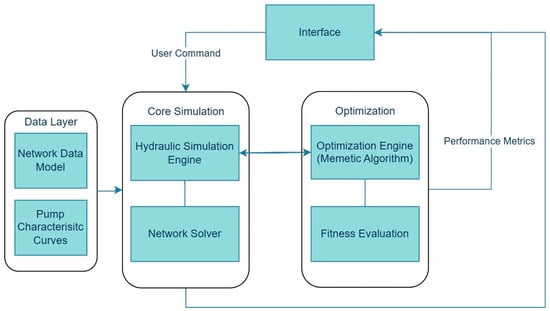
Figure 2.
System architecture for energy-optimized hydraulic network simulation.
The developed framework offers a sophisticated real-time simulation and optimization environment designed specifically for wastewater pumping networks, integrating advanced Memetic Algorithms (MAs) to minimize energy consumption. The solution method consists of different phases that include the solution of the hydraulic system, the input data and their arrangement, and the optimization module that feeds into the simulation the values that the simulation is then going to use in the loop again in order to solve the network. For this model, the case of five parallel centrifugal pumps was considered, each characterized by manufacturer-specific performance curves (as an example of data provided from the manufacturer in Table 1), which describes the relationships between flow rate, total head, and shaft power using polynomial functions.

Table 1.
Example flow [m3/h] and shaft power data [kw].
Parallel pumping configurations, such as the one employed in this study, are commonly adopted in fluid-handling systems within wastewater treatment plants (WWTPs) due to their capability to effectively manage both steady-state flow demands and inherent operational fluctuations [28]. These configurations offer enhanced flexibility and redundancy, allowing for scalable response to variable influent loads, seasonal variations, and maintenance contingencies. This operational robustness makes parallel pumping systems a pertinent and realistic context for evaluating advanced optimization algorithms aimed at improving energy efficiency and process reliability.
In this study, the chosen parallel pumping arrangement, in particular five pumps, serves as a representative and challenging use-case for assessing the algorithmic performance under diverse operational scenarios, characteristic of the real-world WWTP environments. The modeling process began with the assimilation of manufacturer-provided performance data for each pump unit, including head, flow, and power consumption curves under a range of operating conditions. This technical data forms the foundation for an accurate representation of pump behavior within the simulation.
Subsequently, the treatment plant configuration was integrated into the model, which incorporated the physical layout of the hydraulic network, the position and status of the isolation and control valves, and any relevant constraints related to flow distribution, head losses, or redundancy requirements. Detailed attention was given to replicating the plant’s piping topology, control logic, and operational setpoints to make sure the simulation reflected the actual process as closely as possible.
The hydraulic simulation engine was modeled and developed in order to solve flow and pressure distributions across the network under various demand scenarios, accounting for head loss, valve statuses, and pump operating points. Solving this network includes detailed computations for quadratic frictional losses and precise rotational speed (RPM) interpolation, notably increasing model accuracy and operational adaptability. In addition to component-level modeling, the hydraulic behavior of the system network is mathematically represented through a graph data model, as shown in a simplified version in Figure 3, that includes a combination of node and arc equations. Nodes represent junctions or components (e.g., pumps, tanks), while arcs denote the flow paths between them. Mass conservation is enforced at each node using continuity equations, and headloss equations (Darcy–Weisbach and empirical polynomial models) are applied to each arc to compute pressure drops or head requirements [29].
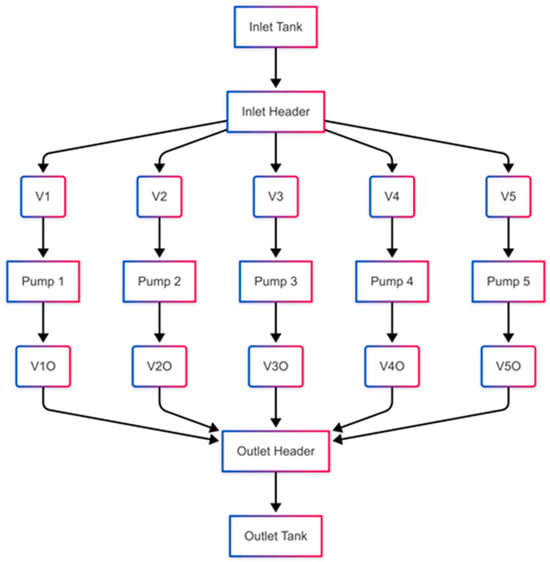
Figure 3.
Hydraulic network topology and data model structure.
These governing equations form a system of non-linear algebraic expressions that are solved iteratively to determine the steady-state flow distribution and pressure profiles through the entire network [30]. This network-based approach ensures that both localized, and system-wide hydraulic interactions are accurately captured, further contributing to the physical fidelity of the simulation outputs. The objective was to capture the dynamic interplay between pump scheduling, network hydraulics, and energy consumption in a manner that supports evaluation and comparison of optimization strategies.
By grounding the simulation framework in real-world engineering parameters and operational constraints, the study provides a platform for analyzing the impact of algorithmic choices on system performance, energy savings, and operational reliability. In order to quantify and evaluate the power reduction, there is the need for a reference “non-optimized” baseline power consumption . This benchmark is defined through a simplified operational strategy, as detailed in Algorithm 1, commonly employed in practical scenarios, where the total required demand is evenly distributed among all available pumps. This “naïve” approach respects each pump’s operational constraints, such as minimum and maximum allowable flow and will be described in Section 2.1.1.
Under this baseline scenario, each pump is allocated an identical fraction of the total flow demand and the corresponding shaft power consumption for each pump is calculated directly from the pump performance curves provided by manufacturer data. This methodology establishes a representative reference against which the efficacy and energy-saving potential of the Memetic Algorithm-driven optimization approach were rigorously evaluated and quantified.
To enhance user interaction and practical usability, the simulation incorporates a specialized WebSocket server, developed using CherryPy and WS4Py, to facilitate real-time, bidirectional communication. This integration supports a user-friendly graphical user interface (GUI), emulating a supervisory control and data acquisition (SCADA)-like environment. Through this intuitive GUI, operators can continuously monitor essential parameters, including total flow demand, flow distribution, energy consumption metrics, and the status and progression of the optimization algorithms. Furthermore, it should enable user-defined adjustments of critical operational parameters, including resistance coefficients, performance modifiers, and targeted flow values. This flexibility enables the adaptation of the simulation environment dynamically to specific operational contexts, reflecting the complexity and variability inherent in real-world wastewater treatment systems.
To validate the effectiveness of the proposed optimization method, a comprehensive set of simulation runs was performed using stochastic input flow conditions. Specifically, the total flow demand was varied randomly within ±5% of the nominal target value, replicating the inherent variability observed in these kinds of studies of industrial applications [27]. A total of 100 independent simulation runs were executed to assess performance under these fluctuating demand scenarios.
Data collection through each simulation run included detailed performance metrics throughout all generations of the Memetic Algorithm (MA). These metrics included the best, worst, and average fitness values, the chromosome configuration representing the optimal pump arrangement, optimized power consumption, and baseline power consumption determined through the previously mentioned Algorithm 1 for equal flow distribution method.
To further demonstrate the advantages of the Memetic Algorithm, parallel simulations employing a standard genetic algorithm (GA) and a mixed-integer linear programming (MILP) optimization were also conducted under identical conditions. For the MILP approach, a piecewise linear approximation was used to more accurately capture the nonlinear characteristics of the pump Power-Flow Curves within the optimization model.
Additionally, each generation’s execution was carefully monitored, logging timestamps and computational durations. All generated data and results were systematically recorded and exported in a suitable format, enabling comprehensive post-simulation analysis. The collected data were then analyzed to evaluate the significance of the achieved power reductions. Key performance indicators such as mean savings, standard deviation, and confidence intervals were calculated across the 100 runs, providing a quantifiable assessment of the optimization algorithm’s performance under uncertain and dynamic flow conditions.
This validation framework reinforces the technical soundness of the proposed method and underscores its potential as a decision-support tool for operations managers [31] aiming to reduce energy costs, ensure system resilience, and implement data-driven strategies within complex wastewater treatment infrastructures.
2.1.1. Equal Flow Distribution Method
Input:
- : Total required flow rate (e.g., in m3/h)
- N: Number of available pumps
- : Minimum and maximum flow rate of pump iii, for
- : Shaft power curve function for pump i, mapping flow rate Q to power consumption P
Output:
- : Total unoptimized shaft power
| Algorithm 1: |
|
2.1.2. Power Optimization Model
This section outlines the decision logic that governs flow allocation and energy dis- patch of the pumps using a Memetic Algorithm [13,15,32]. Considering a station with parallel pumps.
Denote by:
the volumetric flow rate through pump i, where .
The target total flow is
During operation, the controller must keep the instantaneous delivery rate within a narrow band around a contract value (tolerance ε), while each pump i can be fully off () or run anywhere between its manufacturer limits:
For every active pump, the head to be overcome is expressed at
merges the static lift with quadratic friction losses, where
embeds inlet- and outlet-loss coefficients and the cross-sectional velocity
where:
The hydraulic model then interpolates in real time between catalogued shaft speed: each speed is stored as a quartic head–flow curve.
Given a candidate flow vector , the routine clamps the required head to the feasible band
derives an interpolation factor
and from that estimate both shaft power and rotational speed
where and are the minimum and max RPM.
Total electrical demand is simply
The optimization task:
where each candidate solution (chromosome) is encoded as a real-valued genetic search that minimizes subject to the flow-balance constraint; violations are penalized inside an augmented cost:
In the language of a real-coded GA, the chromosome is simply the flow vector
and every gene is allowed to take either the discrete value 0 (pump i switched off) or any continuous value between its catalogue limits Formally, the search space is therefore the direct product
a mixed discrete/continuous domain on which the real-valued genetic operators (arithmetic crossover, Gaussian mutation, etc.) act. Within this space, the feasible region
collects all flow combinations that satisfy the contractual delivery band. Each individual therefore carries the flow genes and a vector of self-adaptive mutation strengths
Thus, a genotype Is where flows .
We define
which serves as the fitness value fed to the evolutionary operators: maximizing F is exactly the same as minimizing the total electrical power.
The selection follows a k-tournament scheme where
- Input—the current population and a tournament size k (e.g., k = 3).
- Draw competitors—to pick one parent, draw k distinct individuals from P without replacement; every member of P has the same chance of being chosen for this mini-contest.
- Evaluate—compute the fitness F(g) for each of the k competitors.
- Select the winner—keep the individual with the highest fitness (break ties at random). This winner becomes a parent and is pushed into the mating pool.
- Repeat—return the sampled competitors to the main population (sampling with replacement at the tournament level) and repeat Steps 2–4 until the mating pool reaches the desired size (typically the same as the population size).
Because each tournament is an independent random draw, a particularly strong individual may win multiple tournaments and appear several times in the mating pool, while weaker individuals may be excluded entirely. The parameter k controls selection pressure: k = 1 gives pure random selection, whereas larger k values disproportionately favor the fittest chromosomes, accelerating convergence but risking premature loss of diversity.
Adaptive Arithmetic crossover
For every two parents , where each parent consists of the following:
- A flow vector or (one gene per pump).
- A mutation-strength vector (one self-adaptive σ per gene).
then draw a Blend Factor.
where:
- The mean is 0.5, on average, and the offspring inherits equal weights from each parent.
- The standard deviation shrinks linearly from an initial value at generation g = 0 to 0 at the final generation g = G.
- ○
- Early in the run is large and ⇒ α can wander well away from 0.5, encouraging exploration.
- ○
- Late in the run is tiny and ⇒ α stays near 0.5, promoting fine-grained exploitation.
Then, recombine each pump-flow gene
- If α = 0.75, the offspring’s i-th flow sits three-quarters of the way from parent 2 toward parent 1.
- Because flows are real numbers (not bits), this arithmetic mix creates intermediate solutions that may lie outside the parents’ discrete choices—useful for searching continuous design spaces.
Finally, the offspring strength is
- A simple average is enough: it keeps inside the range spanned by the parents, preserving self-adaptation information without biasing toward one line.
- These σ values will mutate again later, continuing to tune the search radii gene-by-gene.
Furthermore, self-adaptive Gaussian mutation with hydraulic repair is performed as follows:
For each gene i:
Update the mutation radius (“strength”) for every gene:
The log-normal rule lets each grow or shrink on its own. If a chromosome is far from the optimum, large positive noise will inflate and encourage bigger jumps; once it homes in, the noise is more likely to be negative, squeezing for finer moves.
Gene perturbation:
This Gaussian kick uses the freshly updated as its step size, so exploration and exploitation are both decided locally, gene by gene.
Hydraulic constraint repair:
- Bounds check—after mutation:
- Flow–balance adjustment—compute the delivery error:
- ○
- If , choose I with and
- ○
- If , choose I with and ,
To intensify the search, a memetic local-search cycle is applied as follows:
- After hydraulic repair, draw a small random subset S
- Define a step size :
- Iterative hill climb (up to L rounds).
- ○
- For each with
- ○
- repair each trial vector to restore feasibility;
- ○
- Compute Objective
Among the three options , keep the one with the lowest .
If no gene in S improves during a full round, exit early.
Finally, Survival Strategy includes Elitism, where after offspring are generated, merging them with the current population, rank by fitness F, and copying the best E solutions unchanged into the next generation. This guarantees that the top performers are never lost.
Replacement (next generation): Fill the remaining slots with the best offspring that are not already elites, preserving diversity while keeping overall quality high.
Stopping rules: Keep a global best record and terminate when
- (i)
- The maximum number of generations is reached,
- (ii)
- Fitness has not improved for a preset stall window (stagnation), or
- (iii)
- The target fitness exceeds a threshold.
2.1.3. MILP—Based Optimization
The mixed-integer linear Programming (MILP) optimization approach was implemented and solved using the PuLP optimization library in Python, version 3.12.2. By employing a piecewise linear representation of the pumps’ power consumption curves, the power consumption was modeled using predefined breakpoints derived from actual performance data (flow rate vs. shaft power). This method makes it possible to represent the nonlinear characteristics of real-world pump efficiency curves with high accuracy. The objective function, the minimization of shaft power consumed by all pumps, is expressed like this:
where
- ‑
- are continuous decision variables representing interpolation weights (values between 0 and 1) assigned to the k-th breakpoint of pump i.
- ‑
- are the shaft power values corresponding to breakpoint k for pump i.
The constraints of the model enforced that the aggregated flow from all pumps matched exactly the required total stochastic demand
The flow delivered by each pump is presented as
Additionally, conditional constraints ensured logical pump activation, requiring each pump’s flow rate to remain strictly within predefined minimum and maximum operational limits:
where is a binary decision variable representing the ON/OFF status of the pump (active: 1, inactive: 0). The model was solved using the CBC solver, an open-source mixed-integer linear programming solver integrated within the PuLP framework.
3. Results
This section presents the outcomes obtained from applying the Memetic Algorithm (MA) to the Parallel Pump Optimization Problem within the operational context of wastewater treatment plants (WWTPs). To rigorously assess the algorithm’s performance, data from 100 independent simulation runs were analyzed, under stochastic flow demand scenarios as detailed previously in Section 2. The Memetic Algorithm consistently delivered important improvement in energy efficiency, achieving an average power reduction of approximately 12% across all runs under variable flow demand conditions.
The convergence behavior of the MA is illustrated in Figure 4, highlighting rapid initial progress in power savings during the first 10 generations. This early rapid improvement underscores the algorithm’s efficiency in exploring promising regions of the solution space. After 15 generations, the improvement rate decreased, entering a stable plateau phase where the solution quality consistently settled at an average reduction of 12.13%. The stabilization at this point suggests the algorithm had effectively reached a near-optimal or optimal solution state.
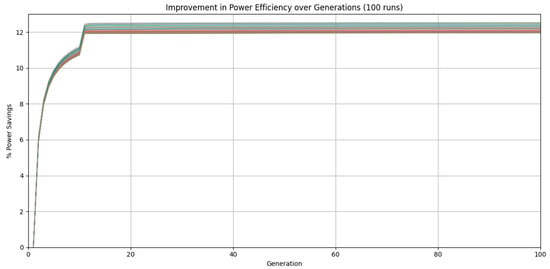
Figure 4.
Convergence trajectories of percentage power savings achieved by the Memetic Algorithm across 100 independent runs. Each thin line represents a single run; the algorithm reaches ≥12% savings within the first 10–15 generations and then stabilizes, indicating reliable convergence to a near-optimal solution.
The reported energy savings are relative to a baseline scenario established through the equal flow distribution method, as described earlier in Section 2.1. This method reflects a pragmatic, yet non-optimized strategy commonly applied in operational practice, providing a clear benchmark to quantify the advantages of the MA-based optimization method.
The Memetic Algorithm consistently demonstrated substantial performance advantages over this baseline, achieving an average energy saving of approximately 12.13%. Statistical analysis further reinforced these findings, revealing a narrow 95% confidence interval tightly bounded between 12.09% and 12.17%. This tight interval not only underscores the algorithm’s robustness and stability but also confirms its capability to reliably achieve near-optimal performance across a range of stochastic flow conditions encountered in WWTP operations.
This is illustrated also in Figure 5, where the distribution of power savings at selected generations using a violin plot is shown. The initial generation (Gen 0) exhibits no savings, serving as a null baseline. By Generation 10, the spread of outcomes is wider, reflecting the exploratory phase of the search process. However, by Generation 15 and onward to Generation 100, the distributions become sharply concentrated around the mean, indicating convergence and stabilization of the optimization process. The consistent performance, as indicated by the minimal variability in results, supports the practical applicability of MA as a dependable solution for real-time operational energy optimization in wastewater treatment systems.
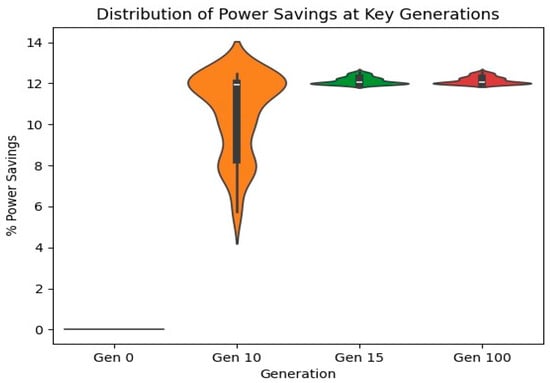
Figure 5.
Violin plots of % power savings: Gen 0 shows no gain; Gen 10 displays wide exploratory spread; by Gen 15 and persisting to Gen 100 the distribution contracts tightly around ≈ 12%, confirming convergence.
The Mann–Whitney U-test was employed to statistically evaluate the differences between the optimized values and the unoptimized values, considering the relatively small sample size and the non-normal distribution of the data. The test produced a U-statistic of 10,000.0 with a p-value approaching zero (p < 0.0001), demonstrating high significant difference between groups at the significance level of . Additionally, the U-value combined with the rank-biserial correlation effect size was −1.0, reflecting a consistent ad definitive difference as it is shown also in Figure 6, meaning the optimized values were consistently lower than those of the unoptimized values.
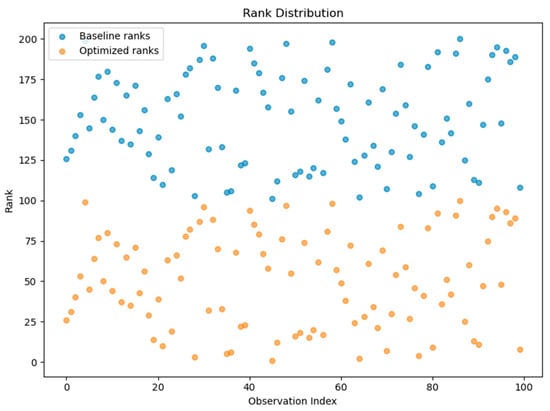
Figure 6.
Rank distribution shows complete separation between baseline and optimized energy consumption.
In Figure 6, all optimized runs (orange) achieved lower ranks (lower energy consumption) than all baseline runs (blue) when ranked together (n = 200 total observations), demonstrating perfect optimization effectiveness. Specifically, the MA demonstrated an average power reduction of approximately 485.64 kW, corresponding directly to the previously reported average savings.
Furthermore, a performance analysis was conducted to evaluate the effectiveness and efficiency of the Memetic Algorithm against traditional optimization approaches, where there was considered a genetic algorithm (GA) and a mixed-integer linear programming (MILP) method using a piecewise-linear approximation. Figure 7 illustrates the convergence profiles of energy savings for these three methods, clearly demonstrating the MA’s superior convergence characteristics. The MA exhibited not only faster convergence toward optimal solutions but also greater stability in performance across stochastic simulation conditions, as evidenced by its relatively lower variability in energy savings over successive generations. This graphical comparison underscores the practical advantages of using the MA for real-time optimization tasks in wastewater pumping systems, highlighting its capability to provide consistent and resilient results even under fluctuating operational demands
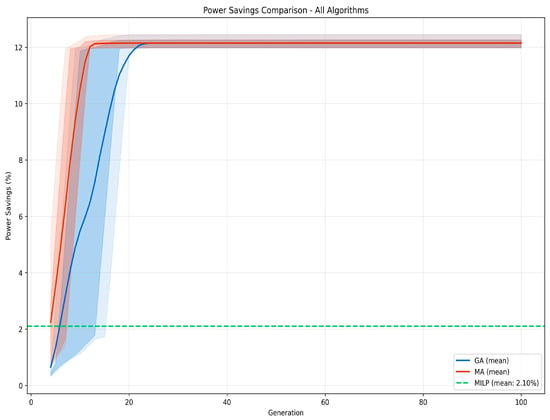
Figure 7.
Average power-savings per generation: MA reaches ≈ 12% within 10 generations, outpacing GA (slower rise) and MILP (plateau ≈ 2%).
The computational performance analysis showed notable differences among the considered optimization methods. Although both the genetic algorithm (GA) and the Memetic Algorithm (MA) eventually converged to comparable final solutions, the MA demonstrated a clear advantage by achieving convergence meaningfully faster, typically within approximately 15 generations, as reported also in Table 2. This rapid convergence indicates the MA’s enhanced capability to efficiently explore and exploit the search space, benefiting from its integrated local refinement process.

Table 2.
Performance comparison between GA and MA.
Figure 8 provides a comparative visualization of computational performance metrics across the MA, GA, and mixed-integer linear programming (MILP) methods. The figure highlights the superior computational efficiency of the MA, consistently achieving quicker convergence compared to the GA, which required a notably higher number of generations to reach similar optimal results. Conversely, the MILP approach exhibited the lowest absolute computational time; however, this faster execution was accompanied by compromised solution quality. The MILP method consistently produced inferior energy-saving results compared to the MA, underscoring the trade-off between computational speed and optimization effectiveness.
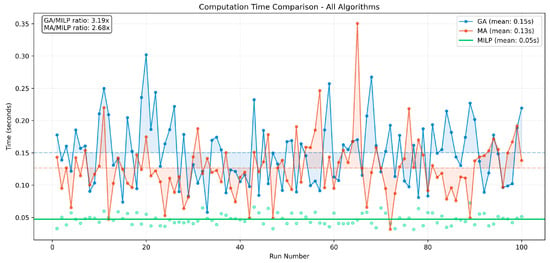
Figure 8.
Average computation time per run: MA ≈ 0.13 s, GA ≈ 0.15 s (both ≈ 3× slower than MILP’s 0.05 s) yet still suitable for real-time use given MA’s higher energy-saving accuracy.
4. Conclusions
Overall, these results position the Memetic Algorithm as an optimal balance of computational efficiency and solution quality, making it appropriate for real-time applications in WWTP operations, where both rapid decision-making and high-quality solutions are critical.
This paper aligns with the development objectives of characteristic systems of Industry 4.0 applications and the integration of complex systems, including the deployment of artificial intelligence within industrial plants and automation. Moreover, it is consistent with the principles of the new European directive on Industry 5.0, which emphasizes research and innovation for improving sustainability in support of a more human-centric, and resilient European industry.
Considering not only the immediate technical contributions, these findings also have broader significance in the context of sustainable infrastructure management. The improvement of these infrastructures contributes directly to global energy conservation goals and carbon emission reduction targets. Furthermore, the demonstrated near real-time computational performance underlines the practical feasibility of integrating the proposed framework into smart water management systems, enabling dynamic and adaptive operational control.
Nevertheless, future implementations should account for additional real-world complexities, including unpredictable operational anomalies, planned maintenance schedules, and sensor inaccuracies. Expanding optimization objectives to encompass system and equipment health monitoring could enhance the durability and reliability of this approach significantly.
Future research should prioritize validating the proposed framework in operational WWTP settings, exploring multi-objective optimization strategies, and integrating real-time data streams to evaluate scalability and adaptability under dynamic operational conditions. These findings align with, and extend, the current body of literature highlighting the strengths of hybrid evolutionary algorithms for addressing complex industrial optimization challenges characterized by nonlinearities and shifting operational contexts. Compared to conventional heuristic or rule-based methodologies, the Memetic Algorithm (MA)-based framework provides superior optimization quality, increased operational flexibility, and enhanced computational efficiency.
This development represents a substantial advancement toward broader sustainability objectives, as outlined in international initiatives such as the Paris Agreement and the EU 2030 Climate and Energy Framework. By reducing energy consumption and associated greenhouse gas emissions in WWTP operations, it contributes meaningfully to global sustainability targets.
The near real-time capabilities of the proposed framework emphasize its suitability for practical implementation, providing WWTP operators with a responsive decision-support tool for effectively managing fluctuating flow demands, operational disruptions, and variable hydraulic conditions without compromising optimization performance.
To conclude, the Memetic Algorithm exhibits considerable potential as an effective decision-support mechanism for WWTP operations. It consistently delivers rapid, reliable, and high-quality optimization outcomes, achieving measurable energy savings and supporting long-term sustainability objectives. Future research and development should address real-world implementation challenges, such as sensor reliability, maintenance constraints, and equipment durability, to fully maximize operational benefits and enhance the general applicability of the approach.
Author Contributions
Conceptualization, A.G.B., M.G. and M.M.; Methodology, A.G.B. and M.G.; software, X.S. and A.G.; Validation, A.G.B.; data curation F.G. and L.C., Formal analysis, X.S.; Investigation, F.G. and L.C.; Writing—original draft, X.S. and A.G.; Writing—review & editing, X.S. and M.G.; Visualization, F.G. and L. C., project administration A.G.B., Supervision, A.G.B., M.G. and M.M. All authors have read and agreed to the published version of the manuscript.
Funding
This research received no external funding.
Institutional Review Board Statement
Not applicable.
Informed Consent Statement
Not applicable.
Data Availability Statement
Data is contained within the article.
Conflicts of Interest
The authors declare no conflicts of interest.
Abbreviations
The following abbreviations are used in this manuscript:
| WWTP | Waste Water Treatment Plant |
| SDGs | Sustainable and Development Goals |
| MA | Memetic Algorithm |
| GA | Genetic Algorithm |
| M&S | Modeling and Simulation |
| AI | Artificial Intelligence |
| GUI | Graphical User Interface |
| SCADA | Supervisory Control and Data Acquisition |
| MILP | Mixed-Integer Linear Programming |
References
- United Nations Framework Convention on Climate Change. Paris Agreement, 2015. Adopted at COP21, Paris, 12 December 2015. Available online: https://www.un.org/en/climatechange/paris-agreement (accessed on 5 May 2025).
- Bruzzone, A.G.; Massei, M.; Sinelshchikov, K.; Ferrari, R.; Cardelli, M. New Generation Interoperable Simulators for Port Operations. In Proceedings of the 35rd European Modeling & Simulation Symposium (EMSS 2023), Athens, Greece, 18–20 September 2023. [Google Scholar] [CrossRef]
- Zhang, S.; Jin, Y.; Chen, W.; Wang, J.; Wang, Y.; Ren, H. Artificial intelligence in wastewater treatment: A data-driven analysis of status and trends. Chemosphere 2023, 336, 139163. [Google Scholar] [CrossRef] [PubMed]
- U.S. Environmental Protection Agency. Water and Energy Efficiency at Utilities and in the Home; U.S. Environmental Protection Agency: Washington, DC, USA, 2021. [Google Scholar]
- U.S. Environmental Protection Agency. Inventory of U.S. Greenhouse Gas Emissions and Sinks: 1990–2022; U.S. Environmental Protection Agency: Washington, DC, USA, 2024. [Google Scholar]
- Water Test Network. Energy Efficiency and Greenhouse Gas Emissions Foresighting Report; James Hutton Limited: Dundee, UK, 2022. [Google Scholar]
- Gono, R.; Namekata, K. Study on Energy Saving Effect of Newly Developed Blowers in Wastewater Treatment Plants. In Proceedings of the 14th IWA Specialized Conference on the Design, Operation and Economics of Large Wastewater Treatment Plants (LWWTP2024)—Selected Papers, Budapest, Hungary, 8–12 September 2024. [Google Scholar] [CrossRef]
- Tsalas, N.; Golfinopoulos, S.K.; Samios, S.; Katsouras, G.; Peroulis, K. Optimization of energy consumption in a wastewater treatment plant: An overview. Energies 2024, 17, 2808. [Google Scholar] [CrossRef]
- Dada, M.A.; Majemite, M.T.; Obaigbena, A.; Daraojimba, O.H.; Oliha, J.S.; Nwokediegwu, Z.Q.S. Review of smart water management: IoT and AI in water and wastewater treatment. World J. Adv. Res. Rev. 2024, 21, 1373–1382. [Google Scholar]
- Sharma, R.; Gupta, H. Harmonizing sustainability in industry 5.0 era: Transformative strategies for cleaner production and sustainable competitive advantage. J. Clean. Prod. 2024, 445, 141118. [Google Scholar] [CrossRef]
- Bruzzone, A.G.; Sciomachen, A.; Gotelli, M.; Giovannetti, A.; Giulianetti, A.; Shamlu, F. Scenario Simulation to Investigate new Solutions for Port Terminals and Plants based on Intelligent Data Fusion and Supply Chain Modeling. In Proceedings of the 26th International Conference on Harbour, Maritime & Multimodal Logistics M&S (HMS 2024), Tenerife, Spain, 18–20 September 2024. [Google Scholar] [CrossRef]
- García Gómez, P.; González-Rodríguez, I.; Vela, C.R. Enhanced memetic search for reducing energy consumption in fuzzy flexible job shops. Integr. Comput.-Aided Eng. 2023, 30, 151–167. [Google Scholar] [CrossRef]
- Pasha, A.; Liu, J.; Rastogi, R. A mathematical model and a memetic algorithm for berth allocation at inland waterway terminals in developing countries. Eng. Appl. Artif. Intell. 2025, 152, 110843. [Google Scholar] [CrossRef]
- Longo, S.; Hospido, A.; Mauricio-Iglesias, M. Energy efficiency in wastewater treatment plants: A framework for benchmarking method selection and application. J. Environ. Manag. 2023, 344, 118624. [Google Scholar] [CrossRef]
- Gu, Y.; Xu, H.; Yang, J.; Li, R. An improved memetic algorithm to solve the energy-efficient distributed flexible job shop scheduling problem with transportation and start-stop constraints. Math. Biosci. Eng. 2023, 20, 21467–21498. [Google Scholar] [CrossRef]
- Yu, X.; Chen, S.; Zhang, X.; Wu, H.; Guo, Y.; Guan, J. Research progress of the artificial intelligence application in wastewater treatment during 2012–2022: A bibliometric analysis. Water Sci. Technol. 2023, 88, 1750–1766. [Google Scholar]
- Capodaglio, A.G.; Callegari, A. Use, Potential, Needs, and Limits of AI in Wastewater Treatment Applications. Water 2025, 17, 170. [Google Scholar] [CrossRef]
- Phan, T.D.; Bertone, E.; Stewart, R.A. Critical review of system dynamics modelling applications for water resources planning and management. Clean. Environ. Syst. 2021, 2, 100031. [Google Scholar] [CrossRef]
- Ghimire, U.; Sarpong, G.; Gude, V.G. Transitioning Wastewater Treatment Plants toward Circular Economy and Energy Sustainability. ACS Omega 2021, 6, 11794–11803. [Google Scholar] [CrossRef]
- Nagpal, M.; Siddique, M.A.; Sharma, K.; Sharma, N.; Mittal, A. Optimizing wastewater treatment through artificial intelligence: Recent advances and future prospects. Water Sci. Technol. 2024, 90, 731–757. [Google Scholar]
- Johnson, H.; Simon, K.; Slocum, A. Data analytics and pump control in a wastewater treatment plant. Appl. Energy 2021, 299, 117289. [Google Scholar] [CrossRef]
- ANSI/HI 9.6.3-2024; Rotodynamic Pumps—Guideline for Operating Regions. American National Standards Institute: Washington, DC, USA, 2024.
- Saady, I.; Majout, B.; El Kafazi, I.; Karim, M.; Bossoufi, B.; El Ouanjli, N.; Mahfoud, S.; Althobaiti, A.; Alghamdi, T.A.H.; Alenezi, M. Improving photovoltaic water pumping system performance with ANN-based direct torque control using real-time simulation. Sci. Rep. 2025, 15, 4024. [Google Scholar]
- Bruzzone, A.G.; Sinelshchikov, K.; Gotelli, M.; Monaci, F.; Sina, X.; Ghisi, F.; Cirillo, L.; Giovannetti, A. Machine Learning and Simulation Modeling Large Offshore and Production Plants to improve Engineering and Construction. Procedia Comput. Sci. 2025, 253, 3318–3324. [Google Scholar] [CrossRef]
- Reddy, K.G.; Mishra, D. Advances in Feature Selection Using Memetic Algorithms: A Comprehensive Review. Wiley Interdiscip. Rev. Data Min. Knowl. Discov. 2025, 15, e70026. [Google Scholar]
- Kambalame, E.; Ndiritu, J. Achieving sustainable water distribution through penalty-free multi-objective evolutionary design optimization. World Water Policy 2024, 11, 499–525. [Google Scholar] [CrossRef]
- Shirajuddin, T.M.; Muhammad, N.S.; Abdullah, J. Optimization problems in water distribution systems using Non-dominated Sorting Genetic Algorithm II: An overview. Ain Shams Eng. J. 2023, 14, 101932. [Google Scholar] [CrossRef]
- Garcia, E. AI-Driven Smart Wastewater Management: Enhancing Urban Water Sustainability and Resource Recovery. 2025. Available online: https://philpapers.org/rec/GARASW-5 (accessed on 20 May 2025).
- Lugo, L.; Segura, C.; Miranda, G. Future Trends in the Design of Memetic Algorithms: The Case of the Linear Ordering Problem. arXiv 2024. [Google Scholar] [CrossRef]
- Wannapop, R.; Jearsiripongkul, T.; Jiamjiroch, K. Adaptive urban drinking water supply model using the effect of node elevation and head loss formula: A case study. Heliyon 2024, 10, e26181. [Google Scholar] [CrossRef] [PubMed]
- Bin Mahmoud, A.A.; Momeni, A.; Piratla, K.R. Optimal Near Real-Time Control of Water Distribution System Operations. Water 2023, 15, 1280. [Google Scholar] [CrossRef]
- Chen, J.; Ning, T.; Xu, G.; Liu, Y. A memetic algorithm for energy-efficient scheduling of integrated production and shipping. Int. J. Comput. Integr. Manuf. 2022, 35, 1246–1268. [Google Scholar]
Disclaimer/Publisher’s Note: The statements, opinions and data contained in all publications are solely those of the individual author(s) and contributor(s) and not of MDPI and/or the editor(s). MDPI and/or the editor(s) disclaim responsibility for any injury to people or property resulting from any ideas, methods, instructions or products referred to in the content. |
© 2025 by the authors. Licensee MDPI, Basel, Switzerland. This article is an open access article distributed under the terms and conditions of the Creative Commons Attribution (CC BY) license (https://creativecommons.org/licenses/by/4.0/).